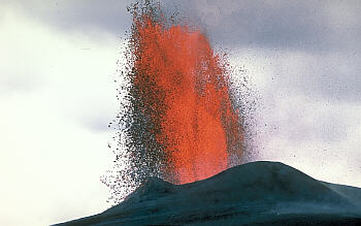 Taken by J.D. Briggs at Kilauea Volcano Hawaiian eruptions are one of the most spectacular natural events that the Earth produces. But how do they occur? Again it is all down to gas and what it is doing beneath the surface and in the conduit. Firstly these eruptions get their name from the Hawaiian island chain where they are most commonly seen, however, the recent Eyjafjallajokull eruption and activity at Mount Etna are also good examples. The basic definition is that these eruptions are continuous and related to a constant 'jet' of gas and magma clots from the vent. This definition is important as it is possible to get very rapid pulsing which should and is usually termed as strombolian. The exact mechanism for Hawaiian eruptions is debated. It is important to think about where gas exsolves from the magma (where it transitions from being dissolved in the magma to a separate gas bubble in the magma). CO2 exsolves at the greatest depth several kilometres below a summit, SO2 is next to exsolve and H2O (the most abundant) within several hundred metres of the surface vent. All this is dependent on amounts of gas present as well. There are two main theories: 1) Hawaiian eruptions occur when magma rise speed at depth is greater than bubble rise speed, this allows the growth of bubbles in the magma. As the magma rises (and the pressure exerted on it decreases) the gas will take up a higher percentage of space (fragmentation) and will also speed up. This will cause the jets of magma which are seen at the surface. 2) This theory depends on a magma foam (magma and gas mixture) accumulating in a magma chamber or shallow storage zone at an area where gas can exsolve (as discussed earlier). This foam region then collapses and feeds into the conduit to rise to the surface where the combined gas/melt mixture is enough to produce fountaining at the surface. Some Hawaiian eruptions are so voluminous in nature that the ejection of magma clots can land and form lava flows of their own as the majority of magma mass erupted doesn't have time to cool. These lava flows are termed 'rootless'. I won't go into landforms any further here, thats a whole separate post involving scoria cones, spatter ramparts. etc Please don't look at the wikipedia page on Hawaiian eruptions it is very disorganised and is not helpful! If you have access to scientific papers, the paper by Parfitt, 2004 called: "A discussion of the mechanisms of explosive baslatic eruptions" is definitely one of the best I have read. On a side note the eruption of Tolbachik is in the midst of a spectacular eruption, involving a mixture of strombolian and hawaiian activity which is producing some lengthy lava flows. There are some excellent photos here taken by Gorshkov Sergey and a discussion on eruptions blog here on the features presented by lava flows. |
Archives
July 2023
|

 RSS Feed
RSS Feed